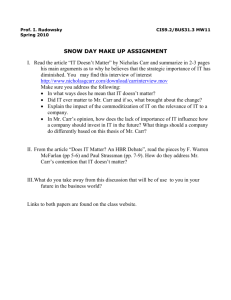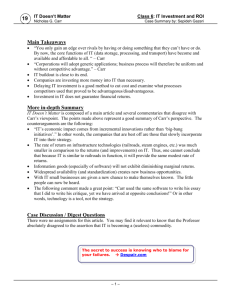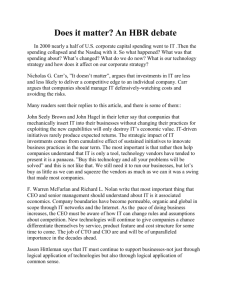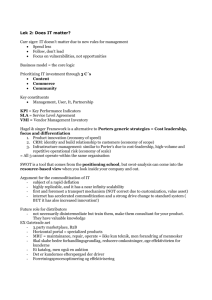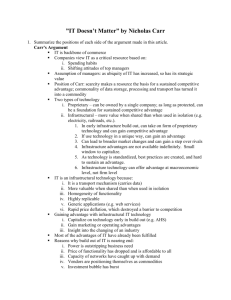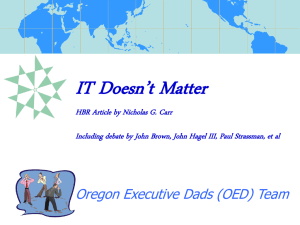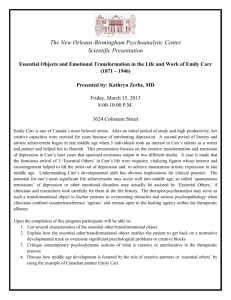NICHOLAS CARR, The Shallows. What the Internet is Doing to Our
advertisement
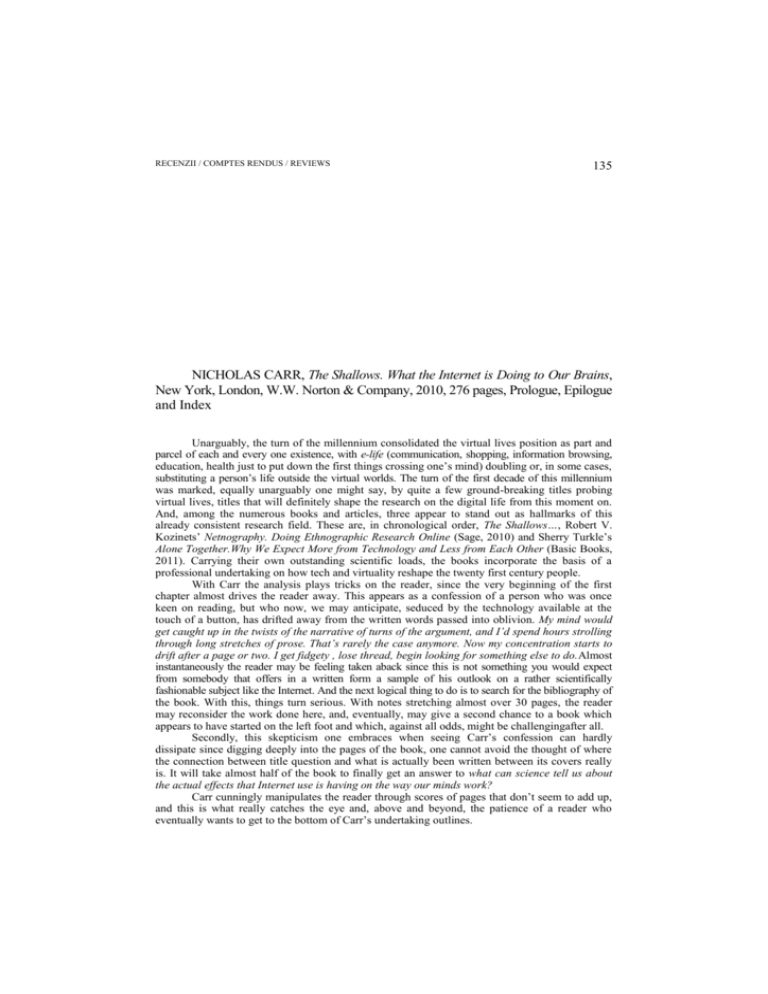
RECENZII / COMPTES RENDUS / REVIEWS 135 NICHOLAS CARR, The Shallows. What the Internet is Doing to Our Brains, New York, London, W.W. Norton & Company, 2010, 276 pages, Prologue, Epilogue and Index Unarguably, the turn of the millennium consolidated the virtual lives position as part and parcel of each and every one existence, with e-life (communication, shopping, information browsing, education, health just to put down the first things crossing one‟s mind) doubling or, in some cases, substituting a person‟s life outside the virtual worlds. The turn of the first decade of this millennium was marked, equally unarguably one might say, by quite a few ground-breaking titles probing virtual lives, titles that will definitely shape the research on the digital life from this moment on. And, among the numerous books and articles, three appear to stand out as hallmarks of this already consistent research field. These are, in chronological order, The Shallows…, Robert V. Kozinets‟ Netnography. Doing Ethnographic Research Online (Sage, 2010) and Sherry Turkle‟s Alone Together.Why We Expect More from Technology and Less from Each Other (Basic Books, 2011). Carrying their own outstanding scientific loads, the books incorporate the basis of a professional undertaking on how tech and virtuality reshape the twenty first century people. With Carr the analysis plays tricks on the reader, since the very beginning of the first chapter almost drives the reader away. This appears as a confession of a person who was once keen on reading, but who now, we may anticipate, seduced by the technology available at the touch of a button, has drifted away from the written words passed into oblivion. My mind would get caught up in the twists of the narrative of turns of the argument, and I‟d spend hours strolling through long stretches of prose. That‟s rarely the case anymore. Now my concentration starts to drift after a page or two. I get fidgety , lose thread, begin looking for something else to do.Almost instantaneously the reader may be feeling taken aback since this is not something you would expect from somebody that offers in a written form a sample of his outlook on a rather scientifically fashionable subject like the Internet. And the next logical thing to do is to search for the bibliography of the book. With this, things turn serious. With notes stretching almost over 30 pages, the reader may reconsider the work done here, and, eventually, may give a second chance to a book which appears to have started on the left foot and which, against all odds, might be challengingafter all. Secondly, this skepticism one embraces when seeing Carr‟s confession can hardly dissipate since digging deeply into the pages of the book, one cannot avoid the thought of where the connection between title question and what is actually been written between its covers really is. It will take almost half of the book to finally get an answer to what can science tell us about the actual effects that Internet use is having on the way our minds work? Carr cunningly manipulates the reader through scores of pages that don‟t seem to add up, and this is what really catches the eye and, above and beyond, the patience of a reader who eventually wants to get to the bottom of Carr‟s undertaking outlines. 136 RECENZII / COMPTES RENDUS / REVIEWS After a brief recollection of his first interaction with a personal computer, which again misleads the reader into thinking this time that the book will be a sort of a self-ethnography of the author‟s relation to technology in its early stages, and after a few pages which historically depict the use of typewriters by means of Nietzche‟s personal experience, the reader reaches what appears to be the very essence of the whole book, that is a minute account on neurological experiments and findings on mapping the brain activity in any given circumstances. For decades, the fact that the neurons are the only cells in the human body that stop multiplying as other die at the age of maturity and that the synaptic connection tends to form patterns which will remain steady along the individual‟s life time was taken for granted. Pioneered by Merzenich‟s research on monkeys, the theory that the adult brain is plastic (that is it renews both its cells and synapses) took shape, was experimented and backed up in the years after by an increasing number of specialists and by means of various types of experiments. Whether we are considering the case of visually challenged people who develop better use of other senses or the case of posttraumatic amputees who proved that the brain can reorganize itself, the broth of chemicals in which the neurons are immersed appears to hold the key in the brain‟s power to readjust, to relocate functions, to enhance abilities or to compensate lacks, as Carr puts it the brain is not the machine we once thought it would be. Thought different regions are associated with different mental functions, the cellular components do not form permanent structures or play rigid roles. They‟re flexible. They change with experience, circumstance, and need. In other words, neuroplasticity can be translated into the ability of the brain to build automatic answers to stimuli after a longer or a shorter period of exposure to such stimuli. This can further be translated, as far as the purpose of the book is concerned, into the technology based development of new synapses which remold the brain‟s response to say internet stimuli, as Carr quotes the current explosion to digital technology not only is changing the way we live and communicate, but is rapidly and profoundly altering the our brains. In order to prove it, Gary Small, a professor of psychiatry at UCLA conducted a very simple experiment. He recruited a number of twenty four volunteers split in half. One half of them were experienced Internet surfers, the other half novices. The professor scanned their brains while googling and the results showed an increasing brain activity for the experimented users in their left frontal lobe. The repetition of the same test six days after the first magnetic imaging subjects exposure revealed that the novices‟ brain activity increased while searching on Google. This change in brainelectric activity was due to the fact that the users had been subjected to an one hour a day internet searching for the previous days. This leads inextricably to the conclusions that exposed to Internet stimuli, the subject‟s brains were taught how to cope with these new stimuli developing an Internet oriented neuroplasticity. But basically, the only connection one can make between the Internet era and the recent development in neuroscience is driven from the fact these two are almost simultaneous „discoveries‟. The influence of „the new‟ on people‟s mind is far longer back stretched. Carr reiterates Socrates‟ laments on what the printed word would do to memory. The first forms of scriptura continua made the early forms of reading like working out a puzzle and this way resembling more a math problems solving test than an actual case of reading as we know it today. The brain must have put its entire cortex to work then and neural activity must have boosted. Then, after the spaces were added, the reading experience reshaped as the brain activity remolded into a simpler pattern of synapse that eventually made reading and automatic experience. Then came the printing era which made reading an experience of disconnection form the external stimuli and of engagement in a world of words, ideas and emotions but which equally posed the threat that people will eventually end up overwhelmed with the amount of printed words around. Then came the TV and audio media, then the Internet all of which, to sum it up brought new challenges the brain had to cope with since, to put it in McLuhan‟s words a new media is never an addition to new one. But even the great McLuhan could not have anticipated what the Internet will showcase in the not very far future a feast […] laid before us: one course after another, each juicier than the last, with hardly a moment to catch our breath between bites. RECENZII / COMPTES RENDUS / REVIEWS 137 Unfortunately, no matter how juicy the courses before us may be, Carr stops his enthusiasm and utters the fragmentation the Internet and the search engines provoke on people‟s minds. Searching on the Internet or simply searching through a book in order to find the most relevant information for what a person is interested in turns into an act of skimming since this process will convert to the impossibility of seeing the trees since only the twigs and leaves are accounted for. His view here is additionally connected to explaining the process of skimming when it comes to Google Book project to digitize all the literature of mankind. This huge undertaking of having a library available on the virtual world is actually as faulty as it can get, since the outcome of such a project is not a library of books. It‟s a library of snippets. Easily moving from one chapter to another, Carr appears to equally feel at ease with shifting from one theme to another, a thing which gives the idea of an off-the-cuff undertaking. But moving towards the half part of his even number chaptered book, Carr actually proves he can master the skills of parallels each subtheme of one chapter having been doubled by a counterpart later on in the text, all reaching a rather disturbing conclusion that, quoting McLuhan, alienation is a by-product of technology, and that technology numb the very faculties. Last but not least, the book can be read as a documentation source, both for a specialist and for somebody accustomed to read popular science books. Well written, far from the stiffness of scientific writing, the books stand out as a successful combination of styles and information rendering, making it a rather easy to deal with account on the history of change related to orality, scripturality, video and audio media and the Internet, written text from papyrus to ebooks, brain functioning, IQ development and human vs. technology relationship. ADRIAN STOICESCU Faculty of Letters, University of Bucharest
